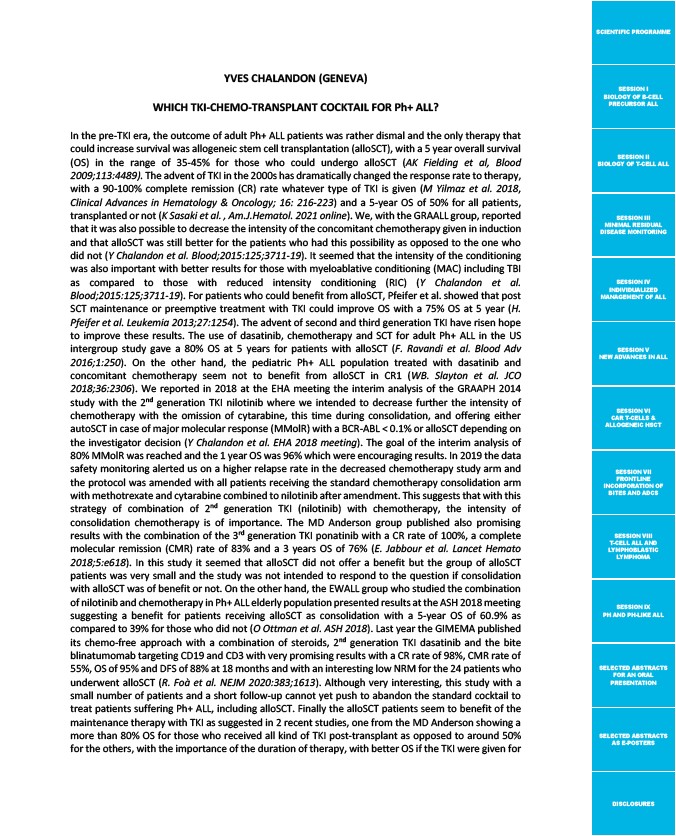
SCIENTIFIC PROGRAMME
SESSION I
BIOLOGY OF B-CELL
PRECURSOR ALL
SESSION II
BIOLOGY OF T-CELL ALL
SESSION III
MINIMAL RESIDUAL
DISEASE MONITORING
SESSION IV
INDIVIDUALIZED
MANAGEMENT OF ALL
SESSION V
NEW ADVANCES IN ALL
SESSION VI
CAR T-CELLS &
ALLOGENEIC HSCT
SESSION VII
FRONTLINE
INCORPORATION OF
BITES AND ADCS
SESSION VIII
T-CELL ALL AND
LYMPHOBLASTIC
LYMPHOMA
SESSION IX
PH AND PH-LIKE ALL
SELECTED ABSTRACTS
FOR AN ORAL
PRESENTATION
SELECTED ABSTRACTS
AS E-POSTERS
DISCLOSURES
YVES CHALANDON (GENEVA)
WHICH TKI-CHEMO-TRANSPLANT COCKTAIL FOR Ph+ ALL?
In the pre-TKI era, the outcome of adult Ph+ ALL patients was rather dismal and the only therapy that
could increase survival was allogeneic stem cell transplantation (alloSCT), with a 5 year overall survival
(OS) in the range of 35-45% for those who could undergo alloSCT (AK Fielding et al, Blood
2009;113:4489). The advent of TKI in the 2000s has dramatically changed the response rate to therapy,
with a 90-100% complete remission (CR) rate whatever type of TKI is given (M Yilmaz et al. 2018,
Clinical Advances in Hematology & Oncology; 16: 216-223) and a 5-year OS of 50% for all patients,
transplanted or not (K Sasaki et al. , Am.J.Hematol. 2021 online). We, with the GRAALL group, reported
that it was also possible to decrease the intensity of the concomitant chemotherapy given in induction
and that alloSCT was still better for the patients who had this possibility as opposed to the one who
did not (Y Chalandon et al. Blood;2015:125;3711-19). It seemed that the intensity of the conditioning
was also important with better results for those with myeloablative conditioning (MAC) including TBI
as compared to those with reduced intensity conditioning (RIC) (Y Chalandon et al.
Blood;2015:125;3711-19). For patients who could benefit from alloSCT, Pfeifer et al. showed that post
SCT maintenance or preemptive treatment with TKI could improve OS with a 75% OS at 5 year (H.
Pfeifer et al. Leukemia 2013;27:1254). The advent of second and third generation TKI have risen hope
to improve these results. The use of dasatinib, chemotherapy and SCT for adult Ph+ ALL in the US
intergroup study gave a 80% OS at 5 years for patients with alloSCT (F. Ravandi et al. Blood Adv
2016;1:250). On the other hand, the pediatric Ph+ ALL population treated with dasatinib and
concomitant chemotherapy seem not to benefit from alloSCT in CR1 (WB. Slayton et al. JCO
2018;36:2306). We reported in 2018 at the EHA meeting the interim analysis of the GRAAPH 2014
study with the 2nd generation TKI nilotinib where we intended to decrease further the intensity of
chemotherapy with the omission of cytarabine, this time during consolidation, and offering either
autoSCT in case of major molecular response (MMolR) with a BCR-ABL < 0.1% or alloSCT depending on
the investigator decision (Y Chalandon et al. EHA 2018 meeting). The goal of the interim analysis of
80% MMolR was reached and the 1 year OS was 96% which were encouraging results. In 2019 the data
safety monitoring alerted us on a higher relapse rate in the decreased chemotherapy study arm and
the protocol was amended with all patients receiving the standard chemotherapy consolidation arm
with methotrexate and cytarabine combined to nilotinib after amendment. This suggests that with this
strategy of combination of 2nd generation TKI (nilotinib) with chemotherapy, the intensity of
consolidation chemotherapy is of importance. The MD Anderson group published also promising
results with the combination of the 3rd generation TKI ponatinib with a CR rate of 100%, a complete
molecular remission (CMR) rate of 83% and a 3 years OS of 76% (E. Jabbour et al. Lancet Hemato
2018;5:e618). In this study it seemed that alloSCT did not offer a benefit but the group of alloSCT
patients was very small and the study was not intended to respond to the question if consolidation
with alloSCT was of benefit or not. On the other hand, the EWALL group who studied the combination
of nilotinib and chemotherapy in Ph+ ALL elderly population presented results at the ASH 2018 meeting
suggesting a benefit for patients receiving alloSCT as consolidation with a 5-year OS of 60.9% as
compared to 39% for those who did not (O Ottman et al. ASH 2018). Last year the GIMEMA published
its chemo-free approach with a combination of steroids, 2nd generation TKI dasatinib and the bite
blinatumomab targeting CD19 and CD3 with very promising results with a CR rate of 98%, CMR rate of
55%, OS of 95% and DFS of 88% at 18 months and with an interesting low NRM for the 24 patients who
underwent alloSCT (R. Foà et al. NEJM 2020:383;1613). Although very interesting, this study with a
small number of patients and a short follow-up cannot yet push to abandon the standard cocktail to
treat patients suffering Ph+ ALL, including alloSCT. Finally the alloSCT patients seem to benefit of the
maintenance therapy with TKI as suggested in 2 recent studies, one from the MD Anderson showing a
more than 80% OS for those who received all kind of TKI post-transplant as opposed to around 50%
for the others, with the importance of the duration of therapy, with better OS if the TKI were given for